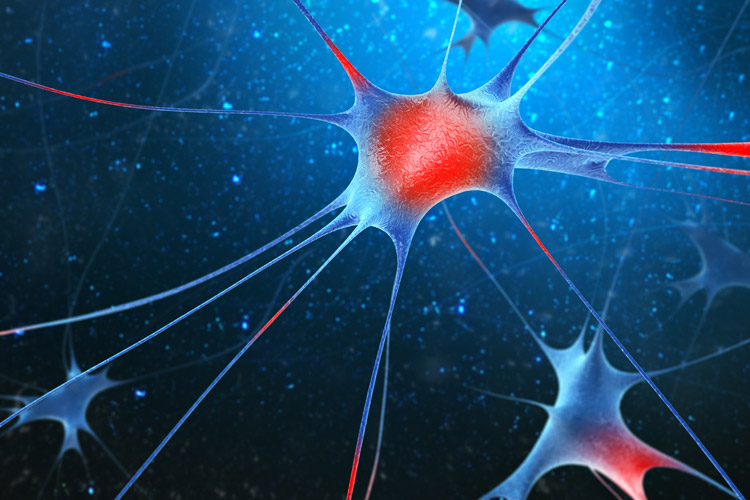
Chronic pain patients often suffer from impaired cognitive function as a side effect of their pain. That degradation isn’t addressed by pain-relief medications, some of which can even make the deficit worse.
Researchers at The University of Texas at Dallas have pinpointed a single biochemical pathway as a target for addressing both this neuropathic pain and the accompanying cognitive problems.
Dr. Ted Price BS’97, Eugene McDermott Professor of neuroscience in UT Dallas’ School of Behavioral and Brain Sciences (BBS), is senior author of a study in mice published online in October in the journal Neuropsychopharmacology describing the pathway.
“One problem with existing pain medicine is that it only manages symptoms. What we really need are disease-modifying therapies,” he said. “I’m pretty convinced that this target has that potential.”
Neuropathic pain originates from damaged or diseased peripheral nerves, which carry signals between various parts of the body and the brain. This type of pain is spontaneous, with no external trigger, and can be caused by an injury or a host of medical conditions — from diabetes to autoimmune disease. By some estimates, 10% of Americans over the age of 30 suffer from some sort of neuropathy.
In neuropathic pain, an injured peripheral nerve cell gets stuck sending a constant pain signal. Even when that signal is inhibited by pain medications, it doesn’t entirely stop, and the incessant “noise” bombarding the brain can cause the organ to restructure.
“Patients often report that even though their pain is being alleviated, the associated cognitive issues aren’t going away,” Price said. “For that signal to go away completely, we have to fix the underlying issue.”
“One problem with existing pain medicine is that it only manages symptoms. What we really need are disease-modifying therapies. I’m pretty convinced that this target has that potential.”
Dr. Ted Price BS’97, Eugene McDermott Professor of neuroscience in the School of Behavioral and Brain Sciences
The exact nature of the changes in the brain during chronic pain has long been a mystery. But Price’s group is making headway in grasping the changes at the molecular level that impede mental focus and critical thinking.
“We’re getting closer to knowing how executive deficit happens with neuropathic pain,” Price said. “Human imaging studies show that the prefrontal cortex, which is involved with decision-making and attention, gets smaller in neuropathic pain sufferers through a process called cortical thinning. And treating the pain does not reverse this change.”
Stephanie Shiers PhD’19, the paper’s lead author and a research assistant in Price’s lab, said their research suggests that abnormal protein synthesis in damaged nerve cells might be driving excessive pain signals as well as altering brain-cell structure. Their focus is on an enzyme involved in protein synthesis called MAP (mitogen-activated protein) kinase-interacting kinase (MNK).
“There’s no one place that this pain starts. It varies by type of injury, or type of disease if it’s generated by chemotherapy or diabetes. If someone’s immune system is compromised, their pain experience may also be different,” Shiers said. “By regaining control over what proteins are being created, we could hit all of these problems, bring every pathology under one umbrella.”
In focusing on the enzyme MNK, researchers sought to regain that control via one segment of a pain-signaling pathway. MNK is a domino in a sequence of biochemical events that leads to changes in the central nervous system.
Using both genetic manipulations and an investigational drug, the researchers inhibited MNK activity in mice with neuropathic pain induced by a peripheral nerve injury. They assessed both the presence of pain and performance in a task requiring prefrontal cortex function.

“There’s no one place that this pain starts. … If someone’s immune system is compromised, their pain experience may also be different. By regaining control over what proteins are being created, we could hit all of these problems, bring every pathology under one umbrella.”
Stephanie Shiers PhD’19, the study’s lead author and a research assistant in Dr. Ted Price’s lab
They found that both the gene manipulation and the pharmacological inhibition of MNK protected against and reversed spontaneous pain and cognitive impairment, while also blocking and reversing the cortical thinning marked by shortening of neurons’ axon initial segments.
Price, a founding member of the University’s new Center for Advanced Pain Studies, first proposed targeting MNK more than 10 years ago.
“We have been working on it forever, slowly building the story,” Price said. “My first big grant from the National Institutes of Health was on MNK. We believe we are the only pain researchers working on this as a target, and from the start, the results have been impressive.”
The investigational drug used in the study, tomivosertib, is an MNK inhibitor currently in phase 3 clinical trials for cancer treatment.
“Tomivosertib is being tested for preventing the spread of tumors,” Price said. “It’s gone through multiple phases, and it seems to be safe, so perhaps it could be optimized for neuropathic pain treatment.”
Shiers indicated that the next step is to investigate drugs that only target the peripheral nervous system.
“One of our long-standing hypotheses is that nociceptors, the peripheral sensory receptors for pain, become hyperactivated to cause neuropathic pain,” she said. “So hopefully, treating the peripheral system only — by using a compound that does not cross the blood-brain barrier — can remove the initial signal that leads to the cognitive dysfunction.”
Additional authors of the paper include Dr. Joseph Pancrazio, vice president for research and professor of bioengineering in the Erik Jonsson School of Engineering and Computer Science; Dr. Greg Dussor, Fellow, Eugene McDermott Professor, and associate professor of neuroscience; Dr. Sven Kroener, associate professor of neuroscience; BBS visiting scientist Dr. Paulino Barragán-Iglesias; bioengineering research scientist Dr. Bryan Black; cognition and neuroscience doctoral student Moeno Kume; biology senior Juliet Mwirigi; and Jamie Moy PhD’17 and Grishma Pradhan BS’15, MS’16.
This research was funded by National Institutes of Health (NIH) grant R01NS065926 through the National Institute of Neurological Disorders and Stroke.
Research Leads to Spinoff Venture
Dr. Ted Price’s work on MAP (mitogen-activated protein) kinase-interacting kinase (MNK) inhibition has led to the formation of a company that will pursue this specific pharmaceutical solution for neuropathic pain.
With Price, a Eugene McDermott Professor of neuroscience, as its co-founder, 4E Therapeutics was created in 2019 to generate an oral MNK inhibitor optimized for neuropathic pain treatment. Last fall, the company received a $1.5 million Small Business Innovation Research award as part of the NIH Helping to End Addiction Long-term Initiative — a program designed specifically to find scientific solutions to halt the national opioid crisis.
“Spinning off a company is the best way to develop a therapeutic,” Price said. “Our goal with this award is to advance an MNK inhibitor to Investigational New Drug (IND) status within five years.”
The company is based on the work of three of Price’s former UT Dallas students: research assistant Stephanie Shiers PhD’19, Jamie Moy PhD’17 and former postdoctoral researcher Dr. Salim Megat. The grant, among other things, will allow Shiers to continue her work on this project, with the aim of bringing it closer to availability.
“Only a handful of people on the planet can say that their work has the potential to directly yield a drug to treat neuropathic pain,” Price said. “She’s pretty excited at the opportunity.”
Shiers agreed: “Being able to see a drug get to the clinic, being used in people, makes this work way more meaningful.”
While the biology-related work happens at UT Dallas, the medicinal chemistry side of the 4E project is supervised by Price’s longtime collaborator Dr. James Sahn, the principal investigator on the grant, vice president of drug development at 4E and formerly a research scientist at UT Austin.
“Our offices are in the Dell Medical School at UT Austin,” Price said. “We are a UT company through and through.”